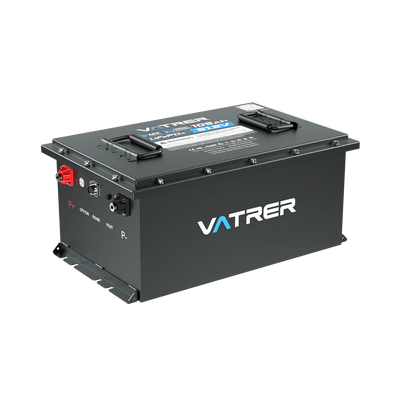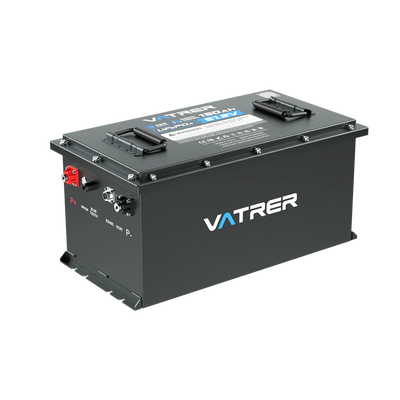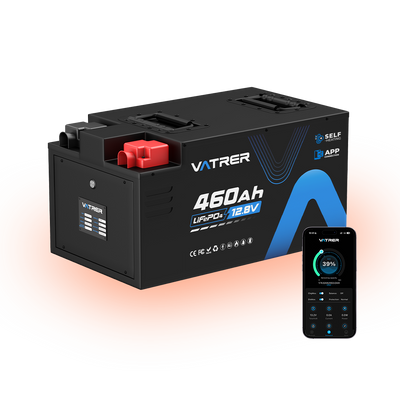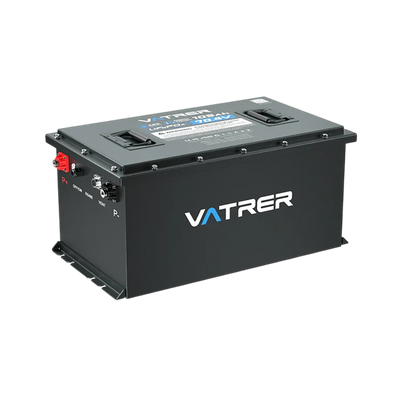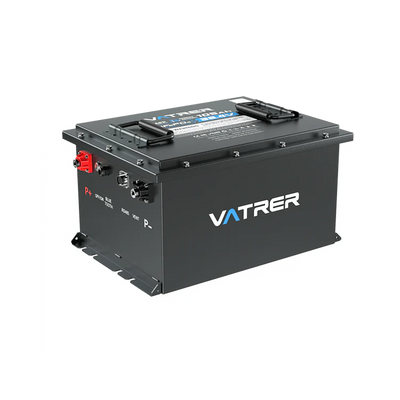
Understanding Different Types of Golf Cart Batteries
The battery is the beating heart of every electric golf cart. It dictates how far your cart can travel, how quickly it accelerates, and how reliable it feels during a long day on the course or in your community. For many owners, the battery is often overlooked, until the cart begins to lose speed, take longer to charge, or suddenly dies mid-round.
Understanding the different types of golf cart batteries can save you from those frustrations. Each battery type, from flooded lead acid batteries to lithium golf cart batteries, offers a unique balance between cost, maintenance, and performance. This guide breaks down how they work, what makes them different, and how to choose the right battery for your golf cart for long-term reliability and savings.

What Are Golf Cart Batteries and How They Work
Unlike the battery in your car, which delivers a short burst of current to start the engine, golf cart batteries are designed to deliver steady, sustained power over many hours. These are called deep-cycle batteries, built to discharge most of their stored energy before recharging without losing performance.
Most electric golf carts use either 36V or 48V battery systems. When cruising around 15 mph, a golf cart typically draws between 50-70 amps of current, much more during steep climbs or acceleration. To meet this demand, individual batteries are wired in series to reach the required system voltage:
- Six 6V batteries — 36V system
- Six 8V batteries — 48V system
- Four 12V batteries — 48V system
However, series-connected golf cart batteries do not work with all battery types. This is common with lead-acid batteries, but if you are using lithium batteries, or if you are planning to upgrade, you only need to purchase a lithium battery pack that matches the voltage of your vehicle's system.
Lower-voltage batteries generally have a higher amp-hour capacity (Ah), meaning more energy storage and longer run time when more units are connected. However, batteries typically last longer when they're not deeply discharged below 50% regularly, a rule that applies to all battery chemistries.
Can You Use Car Batteries in a Golf Cart?
You can, technically, but it's not a good idea. Car batteries are designed for short, high-current bursts to start engines, not for the long, steady output an electric golf cart requires. If used repeatedly in a golf cart, car batteries will degrade rapidly after just a few deep discharge cycles.
Deep-cycle batteries, on the other hand, are engineered to deliver a consistent current over longer durations. They tolerate deep discharges and frequent recharging without significant capacity loss. In short: while a car battery might get you moving, a deep-cycle battery keeps you moving.
Understanding the Main Types of Golf Cart Batteries
Golf cart owners today can choose between several types of batteries, generally divided into lead-acid batteries and lithium batteries. Each has unique strengths, weaknesses, and ideal use cases.
Flooded Lead Acid Batteries (FLA)
Flooded lead acid batteries are the oldest and most common traditional lead acid batteries used in golf carts. They contain lead plates submerged in liquid sulfuric acid. The chemical reaction between the lead and electrolyte produces the energy needed to move your cart.
Pros
- Lowest initial cost — ideal for budget-conscious users
- Well-established and easy to service or replace
- Readily available at most battery retailers
Cons
- Require regular maintenance — checking electrolyte levels, adding distilled water, and cleaning corrosion
- Heavy, which can reduce vehicle efficiency
- More prone to acid leaks or corrosion buildup
Best for owners who don't mind hands-on upkeep and prioritize lower purchase cost over convenience.
Absorbed Glass Mat (AGM) Batteries
Absorbed Glass Mat (AGM) batteries are an upgraded version of the traditional lead-acid design. They use fiberglass mats to hold the electrolyte in place, preventing spills and allowing the battery to be fully sealed.
Pros
- Maintenance-free: No need to add water or check fluid levels
- Spill-proof design: Safer for off-road or rough terrain use
- Fast charging: Can charge up to five times faster than flooded lead acid batteries
- Durable: Originally developed for military and aviation use, offering high vibration resistance
Cons
- Higher cost than flooded batteries
- Only moderate gains in energy capacity or runtime
Best for golf cart owners who want a sealed, reliable option without the maintenance hassle but aren't ready to switch to lithium.
Gel Lead Acid Batteries
Gel batteries replace liquid electrolytes with a thick silica-based gel. This makes them stable and resistant to leaking, even if the casing cracks, a useful feature in hot or cold climates.
Pros
- Maintenance-free — no watering required
- Leak-proof and sealed construction
- Reliable in extreme heat or cold, the gel won't evaporate or freeze easily
Cons
- Lower charge and discharge rates compared to AGM batteries
- More sensitive to improper charging, which can shorten lifespan
Best for environments with temperature extremes or where maintenance access is limited.
Lithium (LiFePO4) Batteries
Modern lithium golf cart batteries, especially those built with lithium iron phosphate (LiFePO4) chemistry, are changing the game. These batteries are lighter, last significantly longer, and require almost no maintenance.
Pros
- Longer lifespan: 4,000-6,000+ charge cycles — up to ten times that of lead-acid batteries
- Lightweight: Roughly half the weight of comparable deep-cycle batteries
- High efficiency: Deliver consistent voltage and near-full capacity even when low on charge
- Fast charging: Typically reach 100% in 2-5 hours
- Safe and smart: Built-in Battery Management Systems (BMS) protect against overcharging, overheating, and short circuits
- Eco-friendly: No acid leaks or toxic gases
Cons
- Higher upfront investment
- May require a compatible lithium charger and, in some cases, minor wiring adjustments
Best for owners seeking the best long-term value, minimal maintenance, quick charging, and dependable power performance year after year.
Comparing the Different Types of Golf Cart Batteries
This comparison makes it clear, while lithium requires a larger initial investment, its longer lifespan, energy efficiency, and low maintenance deliver the best total value over time.
| Battery Type | Initial Cost | Lifespan (Cycles) | Maintenance | Charge Time | Weight | Ideal Use |
|---|---|---|---|---|---|---|
| Flooded Lead Acid | Low | 300–500 | High | 8–12 hours | Heavy | Budget owners |
| AGM | Medium | 500–1,000 | Low | 4–6 hours | Moderate | Occasional owners |
| Gel | Medium–High | 800–1,200 | Low | 6–8 hours | Moderate | Harsh climates |
| Lithium (LiFePO₄) | High | 4,000–6,000+ | Very Low | 2–5 hours | Light | Daily or commercial use |
Why Lithium Golf Cart Batteries Are the Smart Modern Upgrade
Switching from traditional lead-acid batteries to lithium golf cart batteries offers far more than convenience. Lithium batteries deliver consistent voltage, meaning your cart won't gradually lose power as you drive, it stays strong until the very end of the charge.
Their battery management systems (BMS) automatically regulate current, temperature, and voltage to prevent overcharging or overheating, enhancing safety while extending battery life. This technology gives peace of mind to many owners who want a reliable, maintenance-free power source.
And while the initial price may seem higher, the math works in your favor: the total ownership cost (including replacements, maintenance supplies, and downtime) of lithium batteries is lower than that of multiple lead-acid replacements over the same lifespan.
Choosing the Right Battery for Your Golf Cart
To find the right battery for your golf cart, consider your habits and priorities:
- Daily or long-distance use: Go with lithium golf cart batteries for durability, speed, and reliability.
- Occasional or moderate use: AGM batteries provide a balance between maintenance and performance.
- Cold or hot environments: Gel batteries and lithium batteries handle extreme temperatures better.
- Tight budgets or short-term use: Flooded lead acid batteries remain the most affordable entry option.
Before upgrading, ensure your cart's charger is compatible with the chosen battery type. Mixing battery types or using mismatched capacities can cause uneven performance and shorten lifespan. Always replace batteries as a full set, not one at a time.
Conclusion
Understanding the types of golf cart batteries empowers you to make smarter, longer-lasting decisions. Every type of battery has its place, but lithium stands out as the most future-ready option for today's electric golf cart owners.
If you're looking for dependable, high-efficiency power, Vatrer golf cart battery offers advanced deep cycle batteries built with premium LiFePO4 cells. Each unit includes a smart Battery Management System (BMS) for maximum safety and efficiency, fast charging capability, and lightweight construction, giving you more mileage, less maintenance, and a longer lifespan.
Vatrer batteries are purpose-built for golf carts, UTVs, and other electric vehicles, providing clean, reliable energy that supports your lifestyle and reduces total ownership costs.
FAQs
How do I know when my golf cart batteries need to be replaced?
Most golf cart batteries show warning signs before failure. If your cart struggles to reach its normal range, takes much longer to charge, or slows down significantly on hills, your batteries may be nearing the end of their life. Visible corrosion, swelling, or leaking from the terminals are also clear indicators. For lithium golf cart batteries, check your battery management app or BMS data for unusually fast voltage drops or reduced capacity readings.
Can I upgrade my existing golf cart to lithium batteries without changing the motor or controller?
In most cases, yes, but some adjustments may be needed. Lithium batteries like Vatrer golf cart battery packs are designed to replace lead-acid systems with minimal modification. You'll typically need to install a lithium-compatible charger and ensure your cart's speed controller can handle the higher sustained voltage output. Vatrer lithium upgrade kits are plug and play, but professional installation helps guarantee safety and performance.
How should I store golf cart batteries during off-season months?
Proper storage extends your battery's longer lifespan. For lead-acid batteries, fully charge them, clean corrosion from the terminals, and store them in a cool, dry location. Check electrolyte levels and top off with distilled water if needed. Lithium batteries are easier, simply charge them to about 50-70% before storage, disconnect them from the cart, and keep them in an environment above freezing. Their battery management systems (BMS) protect them from self-discharge and temperature-related issues.
What's the difference between amp hours and voltage in golf cart batteries?
Voltage determines how much power your golf cart's motor can access, while amp-hour capacity (Ah) measures how long the battery can sustain that power. Think of voltage as speed and amp hours as distance. A 48V system provides more power than a 36V system, while a higher Ah rating means you can drive longer before needing to recharge. Matching both to your driving habits ensures efficiency and prevents over-discharge.
Are lithium golf cart batteries safe?
Yes, modern lithium systems like LiFePO4 (lithium iron phosphate) are among the safest energy chemistries available. They don't catch fire easily and include integrated Battery Management Systems (BMS) that monitor temperature, voltage, and current. This protects against short circuits, overcharging, and overheating. Compared to traditional lead-acid batteries, lithium batteries are cleaner, non-corrosive, and environmentally safer.
What kind of maintenance do golf cart batteries require?
Maintenance depends on the type of battery. Flooded lead acid batteries need the most care, regular inspection, water refilling, and cleaning around the lead plates and terminals. AGM and gel batteries are sealed and require little attention beyond keeping terminals clean. Lithium batteries are virtually maintenance-free; just monitor charge levels and occasionally check your BMS data. Proper charging habits are key for all types to maximize lifespan.
How long does it take to charge different golf cart batteries?
Charging time varies by chemistry and charger capacity. Flooded lead-acid batteries typically need 8-12 hours for a full charge, while AGM batteries charge in 4-6 hours and gel batteries in 6-8 hours. Lithium golf cart batteries, such as Vatrer's LiFePO4 series, can fully recharge in as little as 2-5 hours using a compatible charger. Fast charging not only improves convenience but also enhances your cart's daily usability.
What are the cost savings of switching to lithium over time?
While lithium batteries cost more upfront, their longer lifespan and low maintenance translate into major savings. A single Vatrer lithium golf cart battery can last as long as replacing several sets of lead-acid batteries, eliminating the costs of water refills, corrosion damage, and frequent replacements. Over a 10-year span, total ownership costs for lithium batteries are significantly lower, especially when factoring in energy efficiency and reduced downtime.
Share












































































